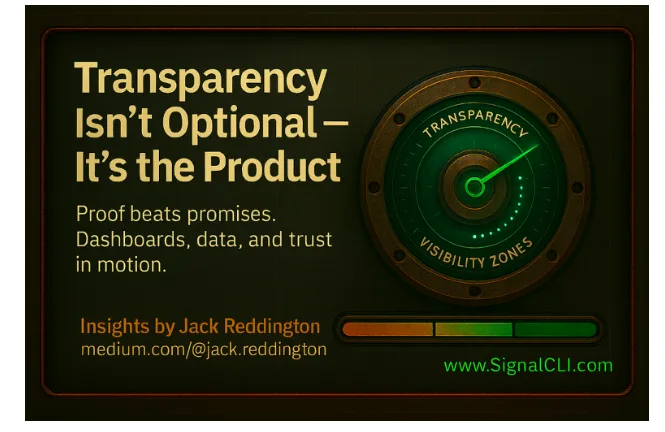Transparency Isn’t Optional in 2025 — It’s the Product
In 2025, investors no longer ask if a trading system works. They ask how well — how often — and how verifiably. Transparency isn’t a perk anymore — it’s the product. The baseline now is transparent performance metrics on a live dashboard, plus a single sample trade with verifiable timestamps. Deeper accuracy zones and the daily schedule remain subscriber‑only.
For years, the financial industry ran on trust. You bought the story. The brand said “trust us,” and you did. But somewhere between meme coins, overnight bankruptcies, and vanishing influencers, people learned to ask for proof. Screenshots no longer cut it. Verified results — timestamped and auditable — do.
The Shift from Performance to Proof
There was a time when charisma was enough. Someone could flash a cropped chart, zoom in on the lucky part, and call it mastery. Audiences applauded, algorithms promoted, capital followed. That era ended the moment people realized how easily a profit curve can be edited.
Now, data is the new charisma. Performance isn’t convincing unless it’s traceable — timestamped — and auditable. Investors want to see accuracy, not as filtered screenshots but as numbers recorded in real time. They want the truth, or at least a version they can verify through timestamps.
Proof doesn’t have to be loud. A single sample trade with verifiable timestamps, paired with concise accuracy reports (mode‑level hit rates, summarized results), is enough to ground the story. The example anchors trust — the stats set expectations.
The Rise of Measurable Systems
Modern traders don’t need promises — they need metrics. Publicly, credible platforms keep it modest and checkable: a live dashboard with baseline performance. The deeper framework — accuracy zones and the daily schedule that explains when accuracy peaks — remains paywalled. That’s not secrecy; it’s IP stewardship.
You can’t fake consistency. Either the math adds up — or it doesn’t. Readers compare what’s visible and verifiable today, then upgrade if the public signal is clean. That split — proof in public, method in private — is what’s winning.
The Anatomy of Real Transparency
True transparency isn’t just about showing results — it’s about showing the conditions behind them. When traders understand why accuracy fluctuates, they make smarter decisions. When they see how volatility affects probability, they learn timing. Transparency, in that sense, becomes education.
The best systems don’t hide their weak spots — they flag them. They label high‑risk hours — mark cooling periods — and note when the algorithms are recalibrating. This honesty builds trust faster than any “100% win rate” ever could.
And it goes deeper — without exposing proprietary timing. Public readers see outcomes; subscribers learn the why and when. The protected layer covers schedule logic and timing frameworks that organize entries, exits, and risk across the trading day.
In a world where automation can run 24/7 — the ability to not trade becomes a sign of intelligence. The platforms that teach restraint are the ones that keep their users profitable.
Timing, Not Fortune‑Telling
Prediction feeds ego — timing feeds accounts. Mature operations emphasize precision‑timed signals and short, actionable windows — think 10‑minute trades executed during scheduled windows. You’re not trying to foresee the next month — you’re catching the next clean push with risk‑managed leverage and letting the math do its job.
That shift — from forecasting to timing — reduces emotional volatility. Traders stop forcing entries in risk‑off windows and learn to wait for high‑probability windows. They stop revenge‑trading and start following the schedule. The result is fewer trades — better trades — and calmer decision‑making.
Why Transparency Became a Competitive Edge
When everything is automated — data becomes the only real differentiator. Anyone can generate signals. Few can show how those signals perform over time — per asset — per zone — per schedule.
That’s why transparency now sells. It’s no longer the fine print — it’s the headline. Traders scroll past marketing and go straight to the metrics. They want to know: how many signals fired this week? What was the hit rate? When did accuracy spike? Was the data independently verifiable? If they can’t find answers — they move on.
The market has matured. In 2019, hype sold. In 2021, the design sold. In 2023, the community sold. In 2025 — data sells.
Transparency also affects retention. When users can track every success and every miss — trust compounds — even when results vary. It’s the digital equivalent of honesty in a relationship: people forgive imperfection — not deception.
The Psychology of Seeing the Numbers
Traders are emotional by design. Seeing results quantified changes behavior. When visible metrics are available on the dashboard — traders become calmer. They follow their plan more strictly. They stop revenge trading because the dashboard shows them exactly when discipline pays.
This happens because transparency creates accountability — both for platforms and for users. If the dashboard shows a weaker hit rate in certain periods — people learn to respect that. If the next high‑probability window shows 80–85% consistency — they act with confidence. Transparency becomes a training tool disguised as a feature.
The paradox? The more people can see — the less reckless they become. Data builds discipline.
How AI Helped Honesty
AI has a reputation problem. It’s accused of opacity — black boxes making mysterious decisions. But in trading — AI forced transparency. Machine‑learning systems log everything. Every signal — every outcome — every recalibration is archived by default. That’s a paper trail no human could fake.
This turned out to be the foundation of the new transparency economy. Automated systems can now show verifiable data without human editing. The algorithm becomes both the analyst — and the witness. Trust shifts from personality — to process — from marketing — to math.
The Business Value of Showing Your Work
Transparency doesn’t just build credibility — it lowers support costs. When users can see data for themselves — they ask fewer questions. They understand why accuracy shifts — why a signal skipped — why volatility spiked. Clear dashboards save both sides time.
It also attracts better users — the kind who think long‑term — not lottery‑ticket traders chasing luck. Transparent systems naturally filter their audience. People who want instant wins leave. People who want structured data stay. Transparency isn’t just honest — it’s efficient.
What Comes Next
The next evolution of trading transparency won’t be visual — it’ll be behavioral. Platforms will adapt dynamically — reducing exposure during risk‑off windows — scaling opportunity during high‑probability windows — and communicating those shifts live. It’s data in motion — not static charts.
Imagine a world where traders don’t ask, “How accurate is it?” but “When is it most accurate?” That’s the pivot transparency created — from outcome to context. In 2025 — context is currency.
Final Word: Trust Is the Product
Transparency isn’t a marketing gimmick — it’s the new benchmark for legitimacy. It’s what separates sustainable platforms from temporary hype. In a landscape built on automation — schedules — zones — precision‑timed signals — and 10‑minute trades — trust is no longer claimed — it’s demonstrated.
And the systems that understand that — those that show their numbers — color their confidence — and publish their timing — aren’t just surviving. They’re defining the standard.
Because in 2025 — transparency doesn’t support the product. It is the product.
About SignalCLI
SignalCLI is a crypto futures signals provider focused on clarity, precision, and informed decision-making. Using a combination of established technical indicators, Smart Money Concepts, and advanced AI analysis, SignalCLI delivers structured, data-driven insights to help traders identify high-probability setups in fast-moving markets. The service is designed for those who value disciplined execution, risk awareness, and timing over speculation. For deeper insights and practical examples, visit www.signalcli.com and explore Jack Reddington’s Medium for trading strategies, market breakdowns, and educational articles.





